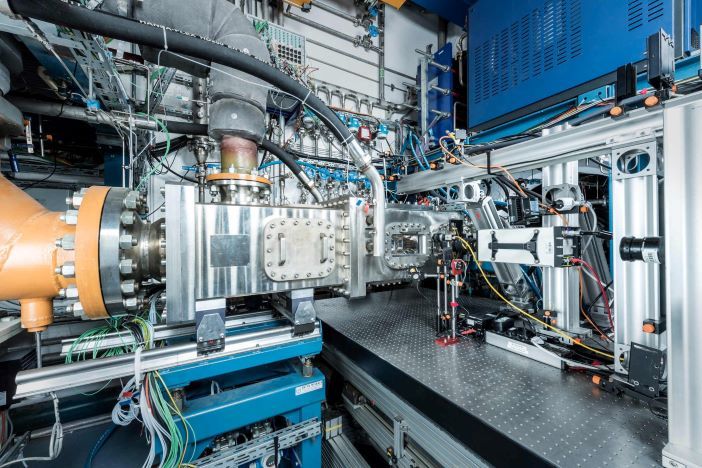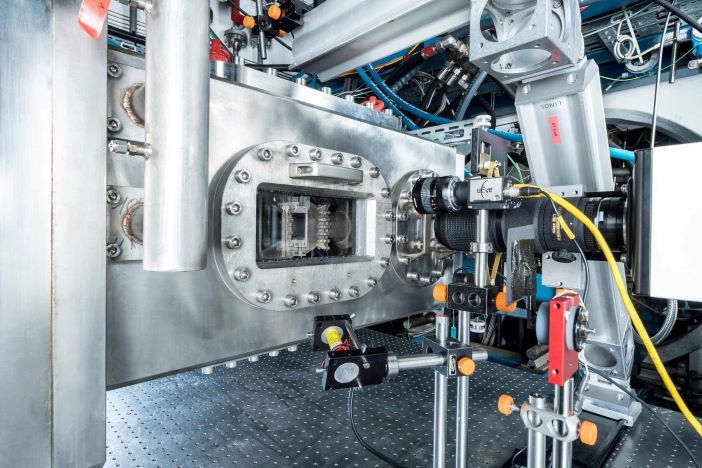The first ground testing of 100% hydrogen combustion under conditions representative of an aircraft engine during flight has been done in Germany as part of a project to convert a GE Passport engine for use in the Airbus ZeroE program.
Researchers from the German Aerospace Center (DLR) and GE Aerospace Advanced Technology are partnering on the testing program and have developed a test rig able to withstand the extreme temperatures and pressures that occur when hydrogen combusts.
The testing at the DLR Institute of Propulsion Technology in Cologne, Germany is part of a three-year, €116 million (US$130 million) EU research project called HYDEA (Hydrogen Demonstrator for Aviation) headed up by Italy’s GE Avio Aero.
HYDEA aims to develop a zero-emission direct hydrogen combustion engine by 2026 and to demonstrate its feasibility in a series of integrated ground tests.
As part of HYDEA, engineers will convert a GE Passport engine to run off hydrogen. The engine will then be integrated into Airbus’ ZEROe flight demonstrator, Airbus’ initiative to develop the world’s first hydrogen-powered commercial aircraft by 2035.
The development of a pure hydrogen engine is challenging for engineers because hydrogen burns in a very different way compared to conventional aviation fuels such as kerosene.
DLR and GE Aerospace have been working on the hydrogen combustion system and the advanced optical measurement techniques that are being used in the ground test campaign at Cologne for four years.
Optical measurements
While hydrogen tests have been carried out under atmospheric conditions in the past, these high-pressure tests are outside of previously defined technological standards. For HYDEA, engineers are investigating hydrogen combustion under different operating conditions.
Dr. Bertram Janus, acting institute director at the Institute for Drive Technology and head of the combustion chamber department at the DLR Institute of Propulsion Technology said, “A new measuring technique was developed especially for this project,”
“With hydrogen combustion in aircraft gas turbines, realistic operating conditions are of fundamental importance. For the first time, we are conducting investigations with this challenging fuel under realistic conditions. The optical access gives us the opportunity for unique data collection.”
Large quartz glass windows enable views of the combustion chamber. Combustion behavior and reacting flow inside the chamber is also characterized using laser-optical measurement methods developed at the Institute.
Dr. Christian Willert, head of the optical engine measurement technology department said, “In the tests we use a range of measurement techniques that, taken together, complete the overall picture of the combustion process and enable the validation of numerical simulations.
“The optical measurements allow instantaneous recording of the reaction and heat release zones without influencing the flow in the combustion chamber. These are supplemented by flow field measurements to track the movement of the air-hydrogen mixture and the reaction products through the combustor.”
Thomas Ripplinger, team leader heat and combustion systems at GE Aerospace Advanced Technology, said, “The measurements, which ran completely smoothly, can be used to assess whether the burner meets expectations or whether design adjustments or changes in the development and design tools are to be carried out”.
DLR and GE Aerospace plan further tests on both the high-pressure combustion chamber test stand, HBK1 and then under even more application-oriented conditions in HBK 2 at DLR in Cologne.

(Image: DLR / CC BY-NC-ND 3.0)





